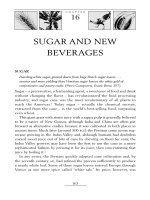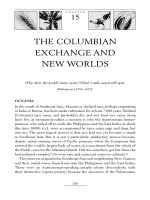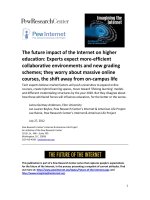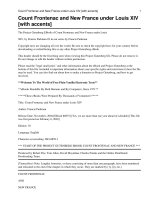SUGAR AND NEW BEVERAGES
Bạn đang xem bản rút gọn của tài liệu. Xem và tải ngay bản đầy đủ của tài liệu tại đây (265.84 KB, 21 trang )
163
CHAPTER
16
SUGAR AND NEW
BEVERAGES
SUGAR
Dazzling-white sugar, ground down from huge Dutch sugar loaves . . .
sweeter and more yielding than Venetian sugar loaves, the white gold of
confectioners and pastry-cooks. (Piero Camporesi, Exotic Brew , 157 )
Sugar – a preservative, a fermenting agent, a sweetener of food and drink
without changing the fl avor – has revolutionized the food processing
industry; and sugar cane was the most revolutionary of all plants to
reach the Americas.
1
Today sugar – actually the chemical sucrose,
extracted from the cane – is the world’s best-selling food, surpassing
even wheat.
This giant grass with stems juicy with a sappy pulp is generally believed
to be a native of New Guinea, although India and China are often put
forward as alternative cradles because it was cultivated in both places in
ancient times. Much later (around 500
BCE
) the Persians came across sug-
arcane growing in the Indus Valley and, although humans had doubtless
coaxed sweet juice out of bits of cane by chewing on them for eons, the
Indus Valley growers may have been the fi rst to use the cane in a more
sophisticated fashion by pressing it for its juice, then concentrating that
juice by boiling it.
2
In any event, the Persians quickly adopted cane cultivation and, by
the seventh century
AD
, had refi ned the process suffi ciently to produce
a nearly white loaf. Some of these sugar loaves entered Europe through
Venice as one more spice called “white salt.” Its price, however, was
164
A Movable Feast
astronomical – only the rich and powerful ever
tasted its sweetness, save perhaps those taking one
or another of the various medicinal preparations
that sugar was almost immediately incorpo-
rated into.
The Arabs, who conquered the Persians in
the ninth century, took over the sugar- making
process and established sugarcane plantations
in a number of places, including Muslim Spain.
Some seven centuries later, both the Spanish
and the Portuguese transferred sugar cultivation
to their possessions off the African coast, where Madeira and the Canary
Islands blossomed into major sugar producers. Slaves were imported from
mainland Africa to work the plantations – the whole a dress rehearsal for
sugar slavery in the New World.
3
By 1518, a number of small sugar plantations had been established in
Híspaniola, and in that year the Atlantic slave trade got underway, the
Spanish pioneering in applying African labor to cane cultivation and sugar
production in the Americas.
4
A couple of decades later, the Portuguese
established a slave trade to Brazil and were even more successful in the
sugar business.
5
In the following century the English, French, and Dutch
grabbed tropical turf from the Iberians to launch their own sugar oper-
ations. Barbados, which the English began to colonize in 1627, led the
already mentioned “sugar revolution.”
6
Initially an island of small tobacco planters whose plots were tended
by white indentured servants, Barbados, by mid-century, was undergoing
transformation into a land of a relatively few large sugar planters whose
fi elds were worked by gangs of African slaves. The techniques learned
in Brazil by the Dutch were passed along to the Barbadian planters,
along with capital for constructing sugar-making factories and acquiring
African slaves. As we pointed out, however, this was not altruism. The
slaves were delivered in Dutch ships and the sugar marketed in Europe
by the Dutch.
This mercantilistic model was, in turn, followed by the English, who
established sugar cultivation in Jamaica (which they had captured in 1655),
and who began taking control of the slave trade. Other major players in the
sugar and slavery business were the Portuguese in Brazil and the French
in Guadalupe, Martinique, and later on, in St. Domingue (Haiti following
Sugar and New Beverages
165
its independence); and, after the sugar industry in St. Domingue dissolved
into the chaos of slave revolution, Cuba emerged to build its nineteenth-
century sugar empire on a contraband slave trade.
7
However, even before Cuban planters rejoiced that their turn to get rich
had arrived, beet sugar (genus Beta) was looming on the competitive horizon.
Beginning around the middle of the eighteenth century, German scientists
and plant breeders had proven increasingly successful in both extracting the
sucrose stored in beet roots and in breeding beets that had a greater sugar
content. Then, with the dawning of a new century, a spate of beet sugar
factory construction suddenly occurred. What may have been the world’s
fi rst such factory went up in Prussia in 1801. Russia, hoping to stop being a
customer of West Indian sugar growers, opened its fi rst factory at about the
same time (in 1801 or 1802), and Austria followed suit in 1803.
Initially the French, although they did some experimenting, mostly
watched these developments from the sidelines – at least they did until
1806, when those blockades the French and the British had erected against
one another cut sharply into the amount of sugar reaching the Continent
from the West Indies.
8
An aroused Napoleon (known to have a sweet
tooth) ordered that upwards of 100,000 acres be planted in sugar beets to
free the French economy from its dependence on colonial imports. There-
after, although the fortunes of beet sugar rose and fell, the new sugar made
steady inroads into what had been a cane sugar monopoly. By the turn of
the twentieth century, the production of beet sugar (a mostly European
effort buttressed by government protection) briefl y surpassed that of cane,
although by century’s end it accounted for only about one-third of all the
world’s sugar.
9
Sugar use in beverages became more uniform after 1872 when Henry
Tate, an English sugar merchant, invented the sugar cube which was instant-
ly popular in both Europe and the Americas. Yet, the cuisines of these two
areas also refl ect differing consequences of yesterday’s sugar availability.
When Europeans visit the United States, they are startled at the sweet-
ness of the pastries. Americans by contrast, fi nd the lack of sugar in the
cakes of Europe off-putting. The reasons for the sweetness of American
versus European baked goods are that historically sugar was always rela-
tively cheap in the Western Hemisphere, whereas it was always relatively
dear in Europe.
A spiraling demand for sugar also had much to do with beverages,
both alcoholic and nonalcoholic (but stimulating nonetheless because of
166
A Movable Feast
caffeine). Three ingredients predominated for the nonalcoholic drinks –
cacao from America, coffee from Africa, and tea from Asia. Together they
fundamentally altered the drinking habits of the globe.
CACAO
Look, there’s no metaphysics on earth like chocolate. (Fernando Pessoa )
Cacao, originally a native of the Amazon region, was enjoyed extensively as
a drink in Mesoamerica during pre-Columbian times, among aristocracies
to be sure, but probably by all classes.
10
The Maya were the fi rst to write
about the secrets of cacao bean processing – fermenting, curing, toasting,
and grinding – to which an array of other ingredients were added, such
as chilli peppers, vanilla, honey, and perhaps, maize. Warm water was the
medium that combined them.
Because cacao contains caffeine and theobromine, it was a stimulating
drink that some Spaniards initially thought to be a kind of wine.
11
Colum-
bus was the fi rst European to encounter cacao beans and noted they were
used as coins.
12
Hérnando Cortéz and his lieutenants adopted the drink
in Mexico during the 1520s and apparently introduced cacao to Spain
where, enhanced with American vanilla, it became the property of that
country’s aristocracy.
13
But although Spain was on the receiving end of a
commerce in New World cacao from the late sixteenth century, decades
elapsed before sugar ensured that the beverage became popular.
14
Hot chocolate may have started its European career as a drink of the
Spanish elite, but it soon charmed elites all over Europe (it did no harm
that chocolate had become known as an aphrodisiac), and by the end of
the seventeenth century, chocolate houses had become commonplace
from Lisbon to London to Livorno.
15
COFFEE
Coffee, which makes the politician wise. (Alexander Pope 1688–1744)
More pervasive and permanent than chocolate in their European impact
were coffee and tea. Coffee originated in the mountains of Ethiopia and
probably Yemen as well, where it was fi rst used extensively as a beverage.
According to legend, around 850
AD
an Ethiopian goatherd, curious about
a strange friskiness among his charges, discovered that the goats were
Sugar and New Beverages
167
nibbling berries from coffee trees. The fi rst humans to use coffee prob-
ably emulated the goats by eating the berries. Mystics – especially the
Sufi monks – used the berries early on, and later on the drink, to produce
visions and to keep them awake during long nighttime rituals.
16
Coffee was drunk in Persia during the ninth century, and the famous
physician Avicenna wrote about it around the year 1000, although at this
point it was still a rare beverage.
17
By the turn of the fi fteenth century,
however, coffee beans were being roasted, ground, and brewed into a bev-
erage, and coffee trees had been brought under cultivation. The Ottoman
Turks introduced coffee to Constantinople in 1454, and by 1500 it was a
common beverage of the Arabian peninsula.
18
Arab merchants shipped the
beans from the Yemeni port of Mocha to an Islamic world, whose enthu-
siastic acceptance of the beverage, after some hesitation, can be traced at
least in part to the Koranic prohibition of alcohol. Coffee provided the
same excuse for socializing and conviviality that alcoholic beverages did
elsewhere.
Coffeehouses became the location of such gatherings; the fi rst is said to
have been established at Constantinople (Istanbul) – that wedge of land
jutting into the confl uence of the Bosporus and the Golden Horn – at
the end of the fi fteenth century. But coffee houses in Baghdad, Damascus,
Mecca, Medina, and Cairo quickly followed, and soon they were as much
a part of the North African landscape as the prickly pear cacti brought
from the Americas by Spain. Attempts to ban the early coffee houses were
frequent because they were suspected of housing too much conviviality in
the form of drug use, prostitution, and suspicious political activity. Yet, a
coffee craze accompanied by offi cial disapproval of coffeehouses was not a
phenomenon confi ned to followers of the Prophet.
Venice, in close contact with the Arabs, the
spice trade, and the Turks who occupied Yemen
in 1536, was exposed to coffee early and appar-
ently saw its fi rst coffeehouse (called caffe and
elsewhere café, eponymous for the drink pur-
veyed) established around the middle of the six-
teenth century. Legend, however, contradicts. It
has coffee only reaching Europeans in1683, in
the aftermath of the Ottoman Turk’s abortive
siege of Vienna, when the Austrians discovered
a veritable mountain of coffee bags left behind
168
A Movable Feast
by the fl eeing Turks – a mountain that spurred Vienna into becoming Cen-
tral Europe’s coffee-processing capital.
19
Like many legends, this one contains some truth. Coffee was a valuable
commodity in the Ottoman Empire, and the Turks jealously guarded what
was essentially their monopoly. But 1683 was hardly the fi rst time coffee
had gotten away from them. Decades before (in 1616), the Dutch had
managed to steal a tree in Aden, and soon were spreading coffee cultiva-
tion throughout the East Indies, while simultaneously introducing the ber-
ries to Europe. England’s fi rst coffeehouse opened in Oxford in 1637. In
France, Marseilles got a coffeehouse in 1671, and Paris the following year,
although the Café Procope, “the fi rst true Paris café,” did not open its doors
until 1686.
20
As coffee consumption grew apace, along with the production of sugar
to sweeten it, the Dutch took coffee trees to Surinam, and in the early
eighteenth century saw them radiate out across the Caribbean. Martinique
was the fi rst West Indies island to grow coffee extensively, followed by
French St. Domingue, and later on Spanish Cuba. On the mainland, coffee
cultivation moved south from Guinea into Brazil, where slave labor was
employed to tend coffee trees as well as sugar cane.
21
Before the St. Domingue slave revolution, France was the world’s big-
gest coffee-producer, satisfying about 60 percent of a European demand
that had grown tenfold in the half-century between 1739 and 1789.
22
But
after the revolution, Brazil took up the slack and bloomed into the world’s
largest coffee grower, producing some 50 percent of the total by the mid-
dle of the nineteenth century. And this happened despite the efforts of
refugee planters from St. Domingue (about to become Haiti), who had
established coffee-plantations in Jamaica, Puerto Rico, Cuba, Colombia,
and Central America.
Planters with smaller scale production methods in some of the new
coffee countries such as Colombia, Jamaica, Costa Rica, and Guatemala
soon concluded that they could not compete with Brazilian coffee in price
and switched to the production of better quality coffee grown in the soil
of their mountainous regions. The champion of quality that emerged was
Jamaica whose rich Blue Mountain coffee has long been widely regarded
as the world’s fi nest.
23
After abolition in 1888, the freedmen in Brazil, as elsewhere in the
hemisphere, were understandably less than enthusiastic about returning to
the coffee fi elds as hired hands. So the planters and their agents recruited
Sugar and New Beverages
169
an army of southern European immigrants to replace them with the focus
on a family work unit – with each family assigned around 5,000 trees.
24
Coffee may have reached southern Europe fi rst, but it was the north-
ern Europeans – the Dutch, the Scandinavians, and the Germans – who
ultimately became its most dedicated imbibers. In England, coffee was at
fi rst closely identifi ed with the academic communities at Oxford and Cam-
bridge. But soon coffeehouses abounded in London so that by 1700 there
were some 2,000 of them.
As coffee percolated down the social scale, its consumption increased
some ten times in the half-century from 1739 to 1789. In Vienna, coffee-
houses drew the customers in with billiard tables; in France it was chess.
Coffeehouses also became vehicles of social and political change. Sultans
had fretted about their potential for bringing troublemakers together –
closing them from time to time with blood-curdling threats – and in 1675,
Charles II of England followed suit by ordering all coffeehouses closed on
the grounds that they were hotbeds of sedition. As the sultans had before
him, he subsequently backed down in the face of public uproar but the
fears of these rulers were not groundless. In France, the 1789 assault on the
Bastille was plotted in a coffeehouse (the Café Foy).
25
Arabica – the trees of which require about four years to mature and
produce a yield of berries – has been the coffee discussed to this point. But
there is another species of coffee tree ( Coffea robusta also C. canephora)
that was found growing wild in the Congo at the turn of the twentieth
century. These trees have the advantage of maturing in only one year and
were quietly cultivated in many parts of Africa (as were a couple of other
minor species) prior to the 1950s. Since then, however, Robusta has come
out of the closet to enter the world market. By 1956, it already accounted
for 22 percent of the world’s coffee crop – with Angola and Kenya its top
producers.
Judged by most to be less tasty than Arabica, Robusta is used in cheaper
blends and is the foundation of instant coffee. War in Angola and political
unrest in Uganda and Kenya have crippled African production, but Viet
Nam has been the benefi ciary. As of 2002, its Robusta production had
helped to send world coffee prices spiraling downward at a dizzying rate.
Following World War II, globalization scattered the complicated machin-
ery for making Italian espresso coffee over all of Europe as well as over all
of the Americas – one says complicated because in the words of a couple of
experts “brewing espresso . . . unlike other methods of brewing coffee . . .
170
A Movable Feast
is rocket science. . . .” And with espresso came a new dimension to the old
European-style coffeehouses.
26
America, on the other hand, contributed a modern version. In 1987,
Howard Shultz bought a Seattle coffee bean business called “Starbucks,”
cleaned up its logo by covering the mermaid’s breasts with her hair, and
began opening coffee bars to supplement his wholesale and mail-order
operations. By 1994, there were almost 500 Starbucks coffee outlets; by
2001, that number had mushroomed to close to 5,000 worldwide. Coffee
globalization was well underway.
TEA
Thank God for tea! What would the world do without tea? How did it
exist? I am glad I was not born before tea. (Sydney Smith 1771–1845 )
Tea ( Camellia sinensis) was the third beverage to catapult a demand for
sugar into the stratosphere. These days tea is drunk by four-fi fths of the
world’s peoples, and daily by about half of them, making it the most con-
sumed beverage on the planet, after water. Nonetheless, it is second to
coffee in international trade because so much of the tea produced never
enters that trade but rather is consumed locally.
Like coffee, the origin of tea (the word derives from Chinese dialect
words such as “Tchai,” “Cha” and “Tay”) is shrouded in legend, although in
this case one reason the legends persist is that facts are hard to come by.
For this we can blame the Han Emperor reigning around 206
BCE
. Clearly
something of a megalomaniac, he ordered all written records destroyed;
the idea was that Chinese history should begin with him.
According to the most often repeated legend, tea drinking began in
China nearly 5,000 years ago when a leaf from a wild tea plant (which
grows from 30 to 40 feet in height) fell into a bowl of boiling water pre-
pared for the emperor Chen Nung.
27
Maybe! But tea leaves were probably fi rst not brewed but eaten as a
vegetable relish, and in some places pickled tea leaves are still consumed
this way.
28
Moreover, one could reasonably expect that the commercial
possibilities of tea as a beverage would not have eluded the Chinese for
close to 3,000 years – in fact until the Han Dynasty (206
BCE
– 220
AD
),
when the shrub was reportedly under cultivation in central and south
China. At the end of the Han era, tea got a mention in the literature as a









